February 13, 2021


The past couple decades have seen an animation renaissance across myriad media. In feature films, television series and streaming content, animation of all types is being produced more than ever before. What remains a mystery to lay audiences and to many industry observers alike is exactly how most animated work is realized, and in what sequence the material is executed. CinemaEditor sets this straight with a spotlight on the work of the editor in select feature length 2020 releases.
 A pair of brothers attempt to conjure the spirit of their deceased father, with assistance from their unconditionally supportive, zany, loving mother in Pixar’s Onward. Directed by Dan Scanlon (Monsters University), Onward is edited by Catherine Apple (Hotel Transylvania).
A pair of brothers attempt to conjure the spirit of their deceased father, with assistance from their unconditionally supportive, zany, loving mother in Pixar’s Onward. Directed by Dan Scanlon (Monsters University), Onward is edited by Catherine Apple (Hotel Transylvania).
“Dan really listens to everybody,” says Apple who worked on the project for two and a half years. “Pixar is a safe place to have ideas. The way we collaborate here is that the story artists work in one room, constantly talking to each other.”
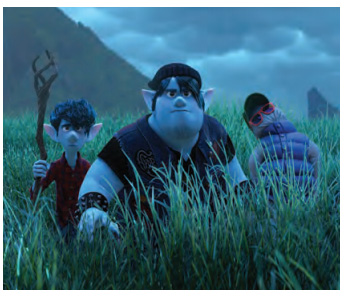 After reading Onward’s script with Pixar’s key creative ‘brain trust,’ Apple edited the artists’ rough renderings of all of the screenplay’s scenes over scratch dialogue. With Scanlon integrally involved, the fully-storyboarded project reverted back to the story department until it was ready for layout. Eventually, the actors were brought in for the recording of finished dialogue, after which final character models were placed and animated in the established 3D environments.
After reading Onward’s script with Pixar’s key creative ‘brain trust,’ Apple edited the artists’ rough renderings of all of the screenplay’s scenes over scratch dialogue. With Scanlon integrally involved, the fully-storyboarded project reverted back to the story department until it was ready for layout. Eventually, the actors were brought in for the recording of finished dialogue, after which final character models were placed and animated in the established 3D environments.
“A lot of my cutting takes place beforehand,” Apple explains of the intricate process. “I have one take, and the choices and dialogue have already been timed out. When we get all of the [final] animation, we cut it to a final cut for mixing.”
In editing the standout mother character, voiced by Julia Louis-Dreyfus, Apple was fastidious with her editing decisions, making detailed choices regarding Louis-Dreyfus’ vocal inflections, tone and enthusiasm with her sons.
“Julia’s vocal performance made it easier and clearer,” Apple states of the final dialogue, as opposed to temp dialogue. “When I first cut the piece, I’m never quite sure if what her expression is saying is what we want to say at the moment. Layout will give me a lot of choices. In animation, we will feel like we need a frame or two longer or shorter. It’s a different stretch for Pixar storytelling-wise, but the same type of world that Pixar has in other movies.”
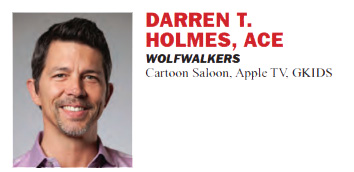 Irish studio Cartoon Saloon’s Wolfwalkers is a father-daughter story from 1650 involving mythical shapeshifters, co-directed by Tomm Moore and Ross Stewart. Editor Darren T. Holmes, ACE, came aboard the project during summer 2018 in the initial storyboarding phase. “You can move scenes around, you can change characters, you can combine characters,” Holmes says of the early days on the project. Holmes was in California, while the remaining creative teams worked in Kilkenny, Ireland.
Irish studio Cartoon Saloon’s Wolfwalkers is a father-daughter story from 1650 involving mythical shapeshifters, co-directed by Tomm Moore and Ross Stewart. Editor Darren T. Holmes, ACE, came aboard the project during summer 2018 in the initial storyboarding phase. “You can move scenes around, you can change characters, you can combine characters,” Holmes says of the early days on the project. Holmes was in California, while the remaining creative teams worked in Kilkenny, Ireland.
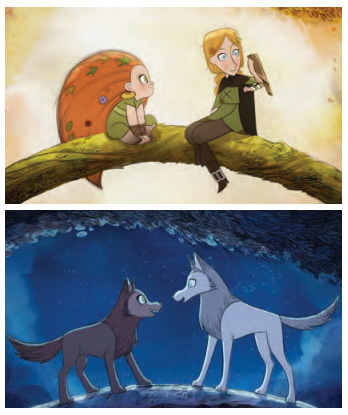 Central to Wolfwalkers is a young girl’s coming-of-age tale. “Wolfwalkers is a triptych, portraying the real Celtic elements of connection with spirit and nature,” he explains. “Robin is a young woman in a very male-dominated culture against the backdrop of the English and Irish conflicts and the basic elements of humanity’s relationship to nature.”
Central to Wolfwalkers is a young girl’s coming-of-age tale. “Wolfwalkers is a triptych, portraying the real Celtic elements of connection with spirit and nature,” he explains. “Robin is a young woman in a very male-dominated culture against the backdrop of the English and Irish conflicts and the basic elements of humanity’s relationship to nature.”
While Holmes was in America cutting sequences, Moore and Stewart continually explored new visuals to tie the story together. “Every few months, they would send me a new version of the whole film. The third act took a year to finalize. Towards the end, I would reassess more of act three each time they sent it, and ensure that things were connecting properly and that the pacing between the moments was working.”
In fact, one scene involves Robin pleading with her father to not kill a character who, unbeknownst to him, is a sentient being. This was iterated for nine months before it went into animation.
Despite the multinational circumstances of Wolfwalkers’ post-production, Holmes notes the implicit trust between all concerned. “I know their artistic sensibilities, and I try to work towards that, protecting their ideas and still attaining what I’m hoping to accomplish with the edit.”
 Esteemed former Disney animator Glen Keane (The Little Mermaid, Aladdin, Pocahontas) was brought in to direct Over the Moon, a musical fantasy told from the perspective of a young girl named Fei Fei. Netflix also hired seasoned animation editor Edie Ichioka, ACE, (The Boxtrolls) to work at Netflix’s Hollywood studio. China’s Pearl Studio, based in Shanghai, was the production company on the project, partnering with Netflix.
Esteemed former Disney animator Glen Keane (The Little Mermaid, Aladdin, Pocahontas) was brought in to direct Over the Moon, a musical fantasy told from the perspective of a young girl named Fei Fei. Netflix also hired seasoned animation editor Edie Ichioka, ACE, (The Boxtrolls) to work at Netflix’s Hollywood studio. China’s Pearl Studio, based in Shanghai, was the production company on the project, partnering with Netflix.
In taking the point-of-view of her lead character, Fei Fei, Ichioka reveals that she based her construction of Over the Moon around the girl, while never losing sight of the overall picture. “Every aspect is analyzed,” Ichioka remarks of her two years on the movie. “It’s a short period of time for creating an 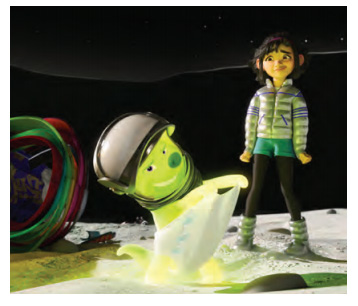 animated feature. We jammed through it, but we were always using our hearts as our guide, making sure you were following Fei Fei’s journey, and that you really felt for her. The great thing about [Pearl’s producers] Gennie Rim and Peilin Chou – and Glenn – is the work is incredibly collaborative.”
animated feature. We jammed through it, but we were always using our hearts as our guide, making sure you were following Fei Fei’s journey, and that you really felt for her. The great thing about [Pearl’s producers] Gennie Rim and Peilin Chou – and Glenn – is the work is incredibly collaborative.”
Several elaborately-conceived musical numbers enhanced the story. “Musicals are such a wonderful way to communicate,” says Ichioka, noting Steven Price’s dynamic score for Over the Moon. “One hidden part of making a musical is you have to make sure that all the railroad tracks join up, because you have all these different types of songs, and you need to make sure that train meets – that’s really, really tricky. You have to feel it, and experience it, and use your own human rhythms. Animation is not taking the tops and tails off shots and connecting them together. It’s sculpting it together with the storyboards and creating something that has its own pulse.”
She adds, “As an Asian American working on a show with an Asian cast, theme and girl, it was just wonderful. I had never worked on a project like this, and it was really inspirational.”
picture. “Every aspect is analyzed,” Ichioka remarks of her two years on the movie. “It’s a short period of time for creating an animated feature. We jammed through it, but we were always using our hearts as our guide, making sure you were following Fei Fei’s journey, and that you really felt for her. The great thing about [Pearl’s producers] Gennie Rim and Peilin Chou –and Glenn – is the work is incredibly collaborative.”
Several elaborately-conceived musical numbers enhanced the story. “Musicals are such a wonderful way to communicate,” says Ichioka, noting Steven Price’s dynamic score for Over the Moon. “One hidden part of making a musical is you have to make sure that all the railroad tracks join up, because you have all these different types of songs, and you need to make sure that train meets – that’s really, really tricky. You have to feel it, and experience it, and use your own human rhythms. Animation is not taking the tops and tails off shots and connecting them together. It’s sculpting it together with the storyboards and creating something that has its own pulse.”
She adds, “As an Asian American working on a show with an Asian cast, theme and girl, it was just wonderful. I had never worked on a project like this, and it was really inspirational.”
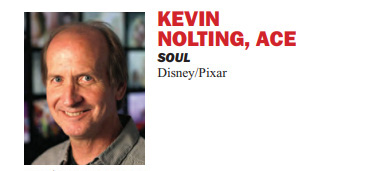 Pixar’s Soul, directed by Pete Docter, concerns a New York jazz musician who visits the spiritual realm of ‘The Great Before,’ an incarnation of the afterlife. Joining the project was frequent Docter collaborator, editor Kevin Nolting, ACE. “Pete is pretty high concept,” says Nolting of his director. “Finding the characters and the story for that takes a long time.”
Pixar’s Soul, directed by Pete Docter, concerns a New York jazz musician who visits the spiritual realm of ‘The Great Before,’ an incarnation of the afterlife. Joining the project was frequent Docter collaborator, editor Kevin Nolting, ACE. “Pete is pretty high concept,” says Nolting of his director. “Finding the characters and the story for that takes a long time.”
In Pixar’s formula, story vetting is critical, and Nolting was immersed in the entirety of the process. “The editors are very involved – part of the re-storyboarding process,” Nolting remarks. “Because of my relationship with Pete, I’m deeply involved in that. Our typical schedule is two and a half years making the movie over and over in storyboards. We spend a lot of time with the camera crew in scenes with a real set and real camera. By the time it gets to animation, camera placement and movement is locked.”
 In the rigorous animation stage, Nolting was involved in cutting scenes with the characters in place. “They don’t get the whole movie at once in animation,” he says. “They get it a scene at a time. We are still storyboarding other parts of the movie. At Pixar, I can concentrate 100% on story. I’m constantly asking whether the character relationships feel real? Is this how this particular character would really react? What do they want? We never look at a scene in isolation.”
In the rigorous animation stage, Nolting was involved in cutting scenes with the characters in place. “They don’t get the whole movie at once in animation,” he says. “They get it a scene at a time. We are still storyboarding other parts of the movie. At Pixar, I can concentrate 100% on story. I’m constantly asking whether the character relationships feel real? Is this how this particular character would really react? What do they want? We never look at a scene in isolation.”
For Soul’s main character of the jazz musician, Joe, Pixar cast Jamie Foxx, who became crucial to the story’s direction midway through production. “Once we brought Jamie in, the character started taking shape,” Nolting recalls. “We try to get the whole movie the first time, almost like a table read. The actors are recorded solo, doing the scenes with somebody reading lines back to them but we’re constantly rewriting. We bring actors like Jamie back at least 10 sessions for rewrites. I stay on through the final mix.” Ultimately, Nolting points to his relationship with Docter being fundamental to their work. “Our taste is very similar. We tend to agree editorially. I’ll do something before he needs to say it. Sometimes you get lucky and click that way, creatively.”
Featured in Content:
1st Quarter, 2021
ACE Board Message
FEATURES
Animation Showcase
The Midnight Sky
News of the World
One Night in Miami
Minari
Mank
Wonder Woman 1984
Nomadland
EDITOR’S CUT
ACE Holiday Party
STOCK FOOTAGE
Aspects of Editing
Tech Corner
Cuts We Love
Related Content
Cuts We Love: “Nobody Wants This”
"Nobody Wants This" Interview by Carolyn Giardina with Maura Corey, ACE, editor of Nobody Wants ThisMore...Explore Your Favorite TopicsEditFestTechnologyInterviewsMoviesNews A short excerpt from the ‘Virtual Glass of Wine’ British Film Editors interview series. David...
Cuts We Love: “The Diplomat”
"The Diplomat" Interview by Carolyn Giardina with Gary Levy, ACE, editor of The DiplomatMore...Explore Your Favorite TopicsEditFestTechnologyInterviewsMoviesNews A short excerpt from the ‘Virtual Glass of Wine’ British Film Editors interview series. David Fairhead BFE...
Explore Your Favorite Topics
EditFest
Technology
Interviews
Movies
News
A short excerpt from the ‘Virtual Glass of Wine’ British Film Editors interview series. David Fairhead BFE talks about the emotions working in the cutting room.
A short excerpt from the ‘Virtual Glass of Wine’ British Film Editors interview series. David Fairhead BFE talks about the emotions working in the cutting room.
A short excerpt from the ‘Virtual Glass of Wine’ British Film Editors interview series. David Fairhead BFE talks about the emotions working in the cutting room.
A short excerpt from the ‘Virtual Glass of Wine’ British Film Editors interview series. David Fairhead BFE talks about the emotions working in the cutting room.
CinemaEditorMag
Television
Editors On Editing
International
All Videos





